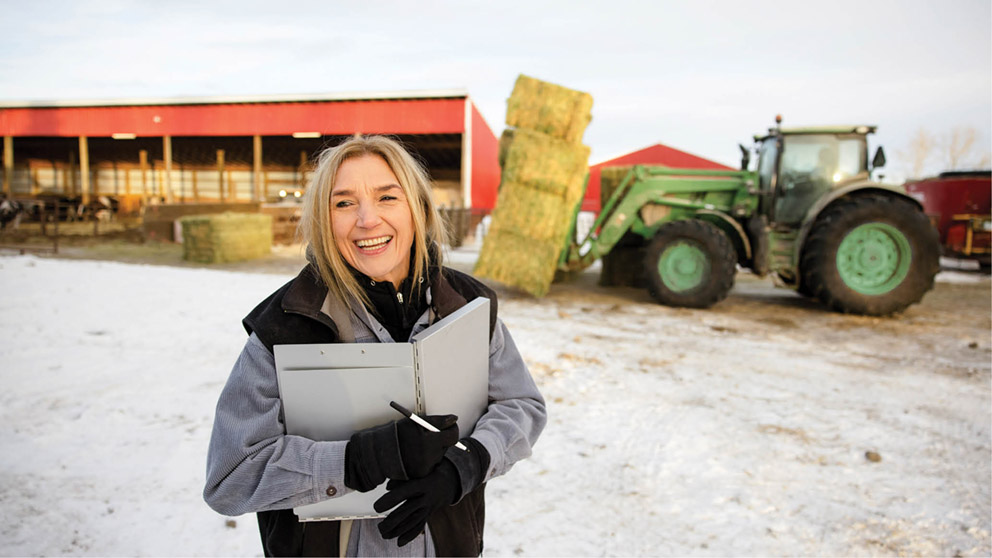Drill down to details and benefit from enterprise analysis

For many farmers, enterprise analysis is all about the big picture – it involves crunching the numbers to see if the entire farm enterprise is profitable and running optimally. But the real benefit of enterprise analysis involves drilling down into each revenue stream within the operation to know which ventures are performing well and which require attention. This can be as general as assessing livestock versus cropping activities or as specific as comparing the performance of commodity soybean production to niche, identity-preserved soybeans.
Know key metrics to optimize inputs and efficiencies
The metrics used to determine profitability can vary by business and depend on your needs.
The metrics used to determine profitability can vary by business and depend on your needs, says Joel Bokenfohr, Edmonton-based business advisor with FCC. Costs and returns are, of course, critical.
“It’s the old theory – you can keep adding inputs as long as you’re adding value,” he says, adding fixed and variable expenses as well as cash flow and margins should be accounted for.
Time is another important consideration, though Bokenfohr refers to it as a “contentious category of unpaid labour.” Unaccounted-for work hides the amount of time investment required to generate each dollar of income. More rigorous tracking can highlight methods of improving time management in addition to the actual cost of production.
Bokenfohr cites two examples from his own experience working with farm businesses.
A multi-generation farm with many ventures — crops, livestock, feed mill, plus off-farm careers — was working through a transition process. The senior generation saw some enterprises as profitable, though time constraints made those same enterprises a less attractive prospect for other family members. As part of the transition planning process, it was decided to prioritize enterprises that accounted for the limited number of work hours available.
A grain grower historically hired custom operators to spray their crops. The cost of custom application was significant, so the grower wanted to start spraying personally. They also kept an off-farm job, however. After accounting for the lost time otherwise devoted to the off-farm job, the use of a custom applicator was deemed more financially worthwhile.
Like businesses in other industries, Bokenfohr says some farms and agribusinesses actively track how much time is devoted to individual tasks, with the explicit intention of identifying and reducing inefficiencies.
Separate revenue streams for a truer picture
Using one bank account for multiple revenue streams is a common practice for farm businesses. However, it can also be a dangerous one since operating expenses become blended.
Determining the fuel cost of an enterprise, for example, requires a proportional division between the amount of fuel used compared to that used for other aspects of the farm. The volumes required to grow soybeans might be different than that required by a livestock business, for example.
The same goes for other inputs and machinery in general. If only 20 per cent of a tractor’s operating time is used in livestock management, the maintenance, repairs, payments and other costs should not be evenly divided.
“Blending costs can build a bit of a false economy. We might be subsidizing part of the farm,” Bokenfohr says. “Knowing those separate costs helps you get a true understanding.”
Does it support or drain other enterprises?
Good record-keeping can also highlight whether an enterprise is having negative or positive effects on other parts of the farm.
“An orchard invested in a cold storage facility because they thought it was needed for a cidery business, which was being run by the younger generation,” Bokenfohr says, in reference to another experience from his career.
“Enterprise analysis showed it was bleeding out the senior generation over time. They ended up renting most of the storage space, and the cidery went back to sourcing elsewhere. They both stayed profitable.”
A similar dynamic can play out in many commodities and value-added products, including farmgate meat sales and processing.
“For farms with value-added products, you often see them discounting the value of [the product] to prop up the processing end. It can also work the other way, where they look to hold their own farm prices and take a hit on the processing end. It can be hard to know which venture is draining them over time if going to one bank account.”
Record all transactions between enterprises
Fundamentally, Bokenfohr reiterates business owners are trying to answer three questions – what am I producing, how am I producing it, and how much? The questions themselves are a reflection of investment, analysis and income statement.
“Start with good foundational record-keeping. Record inputs and transactions between enterprises, then you can do a deep dive and analyze things,” he says, adding scenario planning – specifically, addressing hypothetical situations where costs and revenues might be different – is also very helpful for the longer term.
“Those ‘what ifs’ that happen down the road . . . One year might be more profitable than others. Ask ‘what’s my long-term business plan?’”
Consider business management software and professional advisors
Helpful record-keeping resources are available through a variety of parties, including government and lending institutions such as FCC. Professional advisors can similarly help initiate and guide customers through the enterprise analysis process.
From an AgriSuccess article by Matt McIntosh.

Separating business expenses from personal costs is critical to financial preparedness, but living on the farm creates a unique challenge. These tips will help ensure you know your costs.
